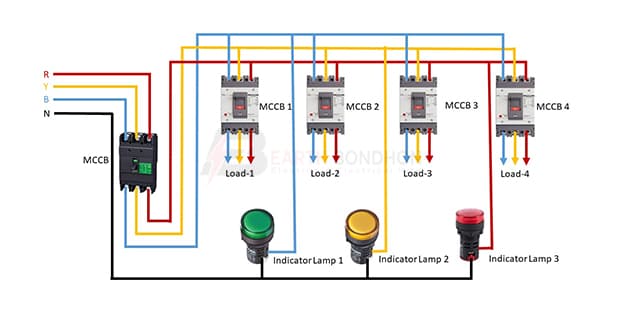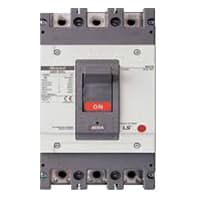3 phase distribution board wiring diagram:
This diagram shows how to make 3 phase distribution board wiring diagram. In this circuit, we use some MCCB ( Molded Case Circuit Breaker ), and three indicator lights. First, we need to connect the main MCCB to a power source, then connect all MCCB and indicator lights to the power source. Now this circuit is ready for use. If you want to know more about this circuit please check our youtube video below the post.
Advertisements
Components needed For this Project:
You can get the components from any of the sites below:
*Please note: These are affiliate links. I may make a commission if you buy the components through these links. I would appreciate your support in this way!
Advertisements
Components used to make the 3 phase distribution board wiring diagram:
The MCCB consists of a bimetallic sheet that expands and contracts when the temperature of the MCCB changes. Due to overload, the bimetallic strip will start to bend and eventually. it will trip if more current flows in the circuit than the predetermined current. The trip mechanism opens the breaker. MCCB stands for Molded Case Circuit Breaker. It is another type of electrical protection device that is used when the load current exceeds the limit of a miniature circuit breaker. The MCCB provides Protection against Overload, and Short Circuit Faults and is also used for Switching the Circuits.
02. Indicator Light:
An indicator lamp just Sounds Technical, Sometimes it is called a Supervisory light Indicator. Indicator lights are amber in color and can be located at the Front, the Rear, and Sometimes at the Side of the car on both the left And Right-hand sides. The Common colors used by Indicator lamps are red, yellow, blue, white, and green line system. A Panel Indicator Lamp Generally has up to 5 Differently Colored Segments to Indicate Various Conditions on the Machine or Process system.
Thank You for visiting the website. Keep visiting for more Updates.
Frequently asked questions
A 3-phase board, also known as a Three Phase Distribution Board or TPN is an essential part of a 3-phase electrical installation. It acts as a central hub that receives power from the electricity grid or a generator and then distributes it to various circuit diagrams within a building or facility.
In the 3-phase power supply, the voltage on each wire is 120 degrees phase shifted relative to each of the other wires. Because it was an AC system, it allowed the voltages to be easily stepped up using transformers to high voltage for the transmission and back down for the distribution, giving high efficiency.
Three-phase Wye nominal low voltages 120 volts/208 volts, and 277 volts/480 volts, are commonly available for commercial and lite industrial buildings. 277 volts was used primarily for commercial office lighting, and 480 volts was used to power large HVAC systems.
Three-phase load balancing occurs when loads of power supplies, such as a 3-phase rack PDU, are spread evenly across all three phases (L1/L2, L2/L3, and L3/L1). It can be achieved by having an equal number of devices plugged into PDU outlets for each phase and drawing an equal power supply load on each phase.
A balanced 3-phase load refers to a condition when all three phases carry the same magnitude of current flow along with the same phase differences. This is due to the loads having equal magnitudes and phase angles. An unbalanced load refers to the condition when unequal currents are carried by the 3 phases.
Read more Single Phase Wiring
What is a kilowatt-hour (kWh) | kwh formula | What does kwh mean
Introduction to Electrical Units and CircuitskW and kWh on your electricity bill As your home uses electricity during...
What is the Difference Between kVA | What does KVA mean | kVA formula
Difference Between KVA ExplainedWhat does KVA Mean? There are technical terms aplenty when it comes to generators, and...
Power Factor | Power Unit | Energy | Electricity Unit
Power factor definition | Calculating Power FactorPower Factor Values In a purely resistive circuit, the power factor...



0 Comments